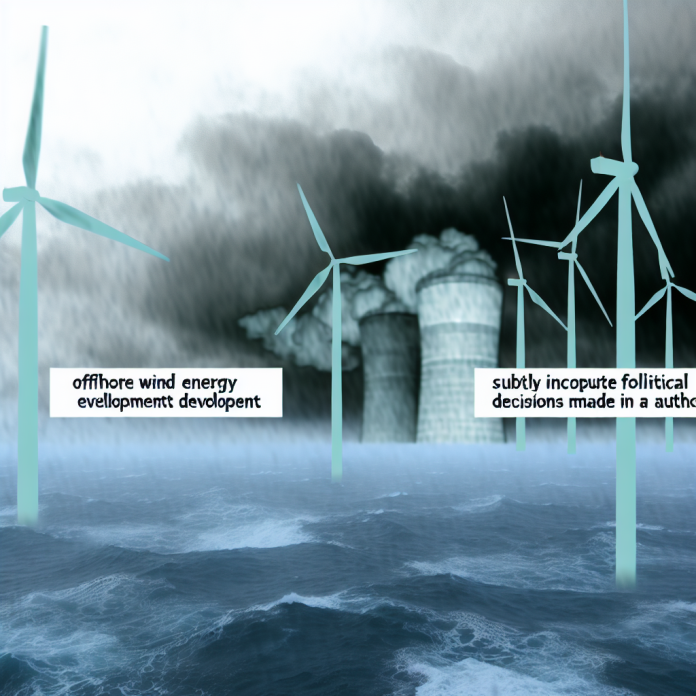Offshore wind energy is poised to revolutionize the renewable energy landscape, harnessing powerful breezes across federal waters to generate clean electricity. As the industry faces significant challenges, particularly under recent Trump administration energy policies, the future of offshore wind development remains uncertain. With over 3.5 million acres initially designated for wind energy lease sales, the cancellation of these plans threatens the United States’ position in renewable energy competition. Federal waters wind projects were anticipated to significantly contribute to state and national energy goals, promoting sustainable practices and reducing reliance on fossil fuels. As advocates for clean energy rally against these setbacks, the demand for progressive offshore wind initiatives has never been more crucial for the nation’s energy future.
The development of offshore wind resources stands at the forefront of the green energy movement, offering a sustainable alternative to traditional energy sources. This emerging sector is facing a slew of challenges, particularly following shifts in energy strategy influenced by recent administration changes. These dynamics play a pivotal role in shaping the conversation around renewable energy opportunities along our coastlines, where harnessing wind power could provide a substantial boost to state economies. The push for wind energy in federal waters reflects a broader effort to combat climate change and promote energy independence. As stakeholders navigate the complex landscape of regulations and market demands, the potential for wind power to transform the energy sector remains an exciting prospect.
The Challenges Facing Offshore Wind Energy Development
Offshore wind energy development in the United States faces significant challenges, particularly under the current administration’s policies. One of the foremost obstacles has been the cancellation of previously designated wind energy areas in federal waters. With 3.5 million acres set aside for wind energy projects, this reversal represents a serious blow to the growth of renewable energy resources. The Bureau of Ocean Energy Management’s decision to halt lease sales off the coasts of key states, including Texas and California, reflects a broader trend of diminishing support for renewable initiatives in federal policy.
Moreover, the opposition to offshore wind stems not only from administrative decisions but also from well-organized local advocacy groups that distrust these development projects. Critics argue that the scale and potential impact on marine ecosystems bring into question the feasibility of offshore wind energy compared to onshore alternatives. This ongoing push against wind energy, paired with regulatory changes, leaves the future of offshore wind development uncertain as competition with fossil fuels intensifies.
Impact of Trump Administration Energy Policies
Energy policies under the Trump administration marked a decisive pivot away from renewable energy strategies towards fossil fuel production. Executive orders issued soon after taking office prioritized oil, gas, and coal, while simultaneously stalling progress on offshore wind projects through a temporary halt on lease sales and the issuance of necessary permits. This policy direction not only undermines the potential for offshore wind energy but supports the long-standing reliance on traditional energy sources that contribute to environmental degradation.
The ramifications of these policies can be felt across the energy sector. By rescinding support for offshore wind initiatives, the administration effectively dismisses the potential of a burgeoning renewable energy market and its associated economic benefits, such as job creation and technological advancements. Additionally, the labeling of wind and solar energy as unreliable by officials has stifled investments and innovation within the sector, placing the U.S. at a disadvantage in the global renewable energy competition.
Renewable Energy Competition and Future Prospects
As the energy landscape shifts, the competition between renewable energies and fossil fuels becomes increasingly pronounced. Governments and private sectors globally are investing heavily in renewable resources, including offshore wind energy, which presents a stark contrast to the U.S. approach under the current administration. Companies engaged in offshore wind development are pushing for technological innovation as they seek to establish a foothold in a rapidly evolving global market. The anticipation surrounding new lease sales in federal waters highlights a future where offshore wind could potentially thrive, despite current setbacks.
The development of federal waters for wind projects represents a crucial battleground in the fight for renewable energy supremacy. With countries like Denmark and Germany leading in offshore wind energy, the U.S. risks falling behind if policies remain unfavorable. Advocates for renewable energy are actively campaigning for legislative changes that could restore and bolster support for offshore projects, emphasizing the need for federal commitment to a cleaner, sustainable energy future.
Navigating Federal Waters for Wind Projects
Federal waters have long been viewed as a promising frontier for wind energy development, with vast areas deemed suitable for harnessing wind power. However, the recent cancellation of planned offshore wind projects under the Trump administration has put these aspirations on hold. The Bureau of Ocean Energy Management’s reconsideration of designated wind areas suggests a significant shift in how federal waters are managed in relation to renewable energy initiatives.
States like New York and California have shown strong support for offshore wind projects, with localized advocacy pushing for the revival of lease sales. The restoration of federally approved offshore wind projects would not only contribute to the renewable energy portfolio but also align with the nation’s goals of reducing carbon emissions. The fate of these wind projects in federal waters underscores the importance of balancing energy interests with environmental stewardship.
The Role of State Governments in Offshore Wind Development
State governments play a vital role in promoting and facilitating offshore wind energy development, especially in light of federal policy changes. With the Trump administration’s reluctance to support renewable energy projects, states like New Jersey and New York have taken the initiative to lead the charge for cleaner energy sources. Local governments collaborate with developers and stakeholders to outline pathways that could benefit both the environment and the economy.
The engagement of state legislators is crucial in driving investments and securing resources for offshore wind projects. As federal support wanes, strategic partnerships among states can create a robust framework for renewable energy initiatives. By prioritizing renewable resources, state governments can set ambitious targets for wind energy production, ultimately contributing to a cleaner energy grid that reflects the needs and values of their constituents.
Environmental Concerns and Offshore Wind Projects
Environmental concerns often arise in discussions about offshore wind projects, particularly pertaining to marine ecosystems and bird mortality rates associated with wind turbines. The Interior Department’s recent announcement to scrutinize these impacts reflects a growing awareness of ecological considerations that accompany offshore wind development. As such, finding a balance between expanding wind energy infrastructure and safeguarding marine life is paramount.
While offshore wind energy offers a cleaner alternative to fossil fuels, the potential negative impacts on wildlife must be addressed. Advocates for offshore wind often highlight the importance of conducting comprehensive environmental assessments to understand and mitigate risks associated with turbine installations. Ensuring that offshore wind projects are implemented responsibly could not only benefit the environment but also enhance public support for renewable energy initiatives as a whole.
Public Perception of Offshore Wind Energy
Public perception plays a crucial role in the acceptance and implementation of offshore wind energy projects. Amidst growing skepticism fueled by political narratives against wind energy, it is essential to bridge the gap between community concerns and scientific consensus on the benefits of renewable resources. Advocacy groups aim to educate the public on the long-term advantages of offshore wind energy, including job creation and enhanced energy security.
Local support for offshore wind often hinges on transparent communication about the environmental, economic, and social implications of such projects. Engaging community members in discussions and providing robust data on wind energy’s efficacy can significantly influence public opinion. By addressing misconceptions and demonstrating the feasibility of these projects, advocates hope to foster a more favorable environment for the future of offshore wind energy in the U.S.
Legislation and Legal Challenges in Wind Energy Projects
Legal challenges have emerged as a significant roadblock for winds energy projects since the Trump administration order to halt leasing and permitting for offshore wind initiatives. Attorneys general from multiple states have filed lawsuits to contest the administration’s actions, asserting that the interference with wind energy projects undermines state interests in promoting renewable resources. These legal battles underscore the contentious atmosphere surrounding wind energy in the current political landscape.
Effective legislation could pave the way for streamlined permitting processes and foster recovery for the wind energy sector. Advocates are pushing for laws that would not only support ongoing projects but also promote new developments in offshore wind energy. By aligning legal frameworks with renewable energy goals, states can help shield wind projects from political fluctuations, ensuring steady progress toward a sustainable energy future.
Economic Benefits of Offshore Wind Energy
Investing in offshore wind energy represents a promising economic opportunity for states and the nation as a whole. The development of offshore wind projects has the potential to generate thousands of jobs in manufacturing, construction, and maintenance sectors, stimulating local economies. With the right policy support, offshore wind energy could significantly contribute to job creation, particularly in coastal regions where economic diversification is essential.
Moreover, the growth of the offshore wind sector can drive technological innovation and supply chain development, enhancing the national energy infrastructure. As more countries transition to renewable energy, the U.S. can position itself as a leader in offshore wind technology, harnessing the economic benefits that come with it. Continued investment in this sector is paramount to realizing both the economic and environmental goals associated with renewable energy development.
Frequently Asked Questions
What are the implications of Trump administration energy policies on offshore wind energy development?
The Trump administration’s energy policies have significantly impacted offshore wind energy development by rescinding plans for federal waters, which aimed to facilitate large offshore wind projects. This shift has halted anticipated lease sales and has discouraged investment in the offshore wind sector.
How do federal waters wind projects affect the offshore wind energy landscape?
Federal waters wind projects are crucial for the offshore wind energy landscape as they provide vast areas designated for development. However, recent policy changes under the Trump administration have curtailed these projects, leading to uncertainty in the sector’s growth.
What constitutes offshore wind lease sales and why are they important for renewable energy competition?
Offshore wind lease sales refer to the government auctioning rights to develop wind energy projects on federal waters. These lease sales are vital for renewable energy competition as they enable developers to invest in sustainable energy sources, but current policy reversals have hindered this process.
How have regulations changed for wind energy lease sales under the Trump administration?
Under the Trump administration, regulations surrounding wind energy lease sales have tightened, with an executive order halting new sales and revising existing permits. This has restricted new wind energy projects from being developed in federal waters.
What challenges does offshore wind development face in light of the current political climate?
Offshore wind development faces numerous challenges, including regulatory hurdles introduced by the Trump administration, public opposition, and competing interests from traditional energy sectors. These challenges complicate the path towards establishing a more robust offshore wind energy infrastructure.
Can you explain the role of the Bureau of Ocean Energy Management in offshore wind energy?
The Bureau of Ocean Energy Management (BOEM) plays a key role in offshore wind energy by designating wind energy areas and conducting lease sales for federal waters. Recent steps taken by the Trump administration have affected BOEM’s ability to promote offshore wind development effectively.
What future outlook is there for offshore wind energy projects given recent policy changes?
The future outlook for offshore wind energy projects is uncertain due to recent policy changes by the Trump administration. While previous plans aimed at expanding wind energy in federal waters have been canceled, ongoing advocacy from state governments and environmental organizations may influence a revival in future policies.
How is the lawsuit from various state attorneys general affecting offshore wind energy projects?
The lawsuit from attorneys general of multiple states challenging Trump’s executive order may create legal hurdles for halting offshore wind energy projects. This legal action reflects the push for maintaining and promoting offshore wind development despite the current administration’s stance.
| Key Points |
|---|
| The Trump administration is cancelling plans for offshore wind development in federal waters, which affects over 3.5 million acres designated for this purpose. |
| The Bureau of Ocean Energy Management is rescinding all designated wind energy areas. |
| Executive orders from Trump aimed to increase fossil fuel production and halt offshore wind lease sales. |
| The administration labels wind and solar energy as unreliable and has initiated reviews on bird mortality rates associated with wind turbines. |
| Opposition to offshore wind projects is vocal in areas like New Jersey, where critics argue against their feasibility compared to onshore power. |
| Legal challenges to Trump’s halting of wind energy projects are being mounted by 17 states and the District of Columbia. |
| The first commercial-scale offshore wind farm was launched last year near Montauk Point, New York, signaling the potential for growth despite regulatory hurdles. |
Summary
Offshore wind energy is facing significant challenges as the Trump administration moves to cancel planned developments in federal waters, totaling more than 3.5 million acres. This action not only halts prospective lease sales across several states but also reflects a broader resistance to renewable energy initiatives. Despite this, advocates continue to push for a transition towards cleaner energy sources, highlighted by legal actions from various states and the recent success of the South Fork project, America’s first commercial-scale offshore wind farm. The future of offshore wind energy will depend on overcoming regulatory obstacles and fostering a greater acceptance of sustainable energy solutions.
Source: https://www.ocregister.com/2025/07/31/trump-wind-energy-canceled/
### Transforming Homes in the Heart of Orange County
In the ever-evolving landscape of home remodeling, **Orange County** stands out as a hotspot for significant renovations, particularly in affluent areas like **Laguna Beach**, **Newport Beach**, and **Irvine**. With a median home value hovering around **$1.18 million**, homeowners are increasingly looking to invest in high-value renovations that elevate their living spaces to new heights. This presents an incredible opportunity for **OC contractors** and remodelers to capitalize on the growing demand for premium home improvements, especially as budgets range from **$50,000 to $500,000** per project.
### Key Considerations for OC Remodeling Projects
Before starting a remodeling project in **Orange County**, homeowners must navigate local building codes and permitting processes that ensure compliance with California regulations. For instance, understanding the specific heights and setbacks applicable in coastal cities like **Huntington Beach** can save both time and cost overruns. Additionally, OC’s climate requires considerations for materials and designs that withstand coastal conditions, making partnerships with reputable suppliers crucial for long-term project success. Contractors who stay updated on these regulations and local climate considerations will not only streamline their processes but also build trust with clients.
### Enhancing Property Value in Newport Beach
Homeowners in **Newport Beach** seeking to boost their property values often turn to upscale kitchen and bathroom remodels. These projects not only enhance daily living but can significantly raise resale values. Contractors specializing in high-end renovations have the chance to showcase their work in open houses, attracting potential clients who value quality craftsmanship. Moreover, contractors can promote their services through local home improvement expos and digital marketing campaigns targeting affluent neighborhoods, strengthening their brand as a go-to for **Newport Beach remodeling**.
### The Growing Demand for Sustainable Remodeling in Irvine
As sustainability becomes a top priority for many homeowners in **Irvine**, contractors have the opportunity to incorporate eco-friendly solutions into their remodeling projects. From energy-efficient appliances to sustainable building materials, there is a growing market for upgrades that align with green living standards. Understanding local incentives for energy-efficient upgrades can also position contractors as knowledgeable partners for clients looking to make environmentally responsible choices.
### Take Action – Engage with Local Professionals
The remodeling landscape in **Orange County** is ripe with potential, offering numerous avenues for contractors and home service professionals to expand their clientele. By staying attuned to local market trends, deeply understanding client needs, and adhering to regulatory standards, contractors can successfully navigate this lucrative environment. For homeowners ready to transform their spaces, engaging with a trusted **OC contractor** can turn visions into reality. Let’s revitalize **Costa Mesa** homes and elevate **Huntington Beach** residences together!


